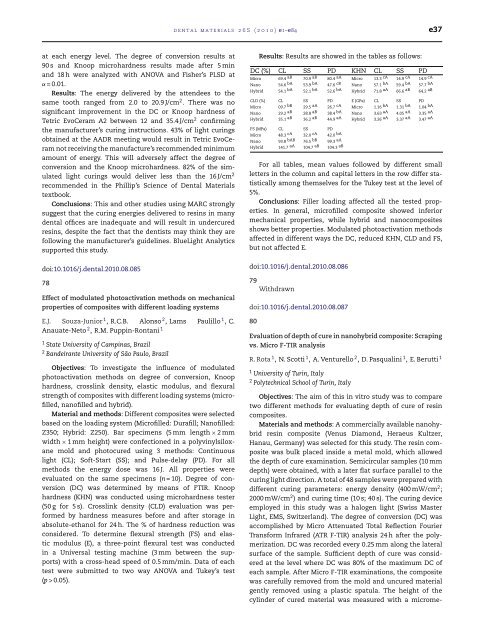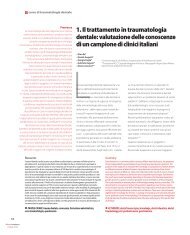Abstracts of the Academy of Dental Materials Annual ... - IsiRed
Abstracts of the Academy of Dental Materials Annual ... - IsiRed
Abstracts of the Academy of Dental Materials Annual ... - IsiRed
You also want an ePaper? Increase the reach of your titles
YUMPU automatically turns print PDFs into web optimized ePapers that Google loves.
at each energy level. The degree <strong>of</strong> conversion results at<br />
90 s and Knoop microhardness results made after 5 min<br />
and 18 h were analyzed with ANOVA and Fisher’s PLSD at<br />
˛ = 0.01.<br />
Results: The energy delivered by <strong>the</strong> attendees to <strong>the</strong><br />
same tooth ranged from 2.0 to 20.9 J/cm 2 . There was no<br />
significant improvement in <strong>the</strong> DC or Knoop hardness <strong>of</strong><br />
Tetric EvoCeram A2 between 12 and 35.4 J/cm 2 confirming<br />
<strong>the</strong> manufacturer’s curing instructions. 43% <strong>of</strong> light curings<br />
obtained at <strong>the</strong> AADR meeting would result in Tetric EvoCeram<br />
not receiving <strong>the</strong> manufacture’s recommended minimum<br />
amount <strong>of</strong> energy. This will adversely affect <strong>the</strong> degree <strong>of</strong><br />
conversion and <strong>the</strong> Knoop microhardness. 82% <strong>of</strong> <strong>the</strong> simulated<br />
light curings would deliver less than <strong>the</strong> 16 J/cm 2<br />
recommended in <strong>the</strong> Phillip’s Science <strong>of</strong> <strong>Dental</strong> <strong>Materials</strong><br />
textbook.<br />
Conclusions: This and o<strong>the</strong>r studies using MARC strongly<br />
suggest that <strong>the</strong> curing energies delivered to resins in many<br />
dental <strong>of</strong>fices are inadequate and will result in undercured<br />
resins, despite <strong>the</strong> fact that <strong>the</strong> dentists may think <strong>the</strong>y are<br />
following <strong>the</strong> manufacturer’s guidelines. BlueLight Analytics<br />
supported this study.<br />
doi:10.1016/j.dental.2010.08.085<br />
78<br />
Effect <strong>of</strong> modulated photoactivation methods on mechanical<br />
properties <strong>of</strong> composites with different loading systems<br />
E.J. Souza-Junior 1 , R.C.B. Alonso 2 , Lams Paulillo 1 ,C.<br />
Anauate-Neto 2 , R.M. Puppin-Rontani 1<br />
1 State University <strong>of</strong> Campinas, Brazil<br />
2 Bandeirante University <strong>of</strong> São Paulo, Brazil<br />
Objectives: To investigate <strong>the</strong> influence <strong>of</strong> modulated<br />
photoactivation methods on degree <strong>of</strong> conversion, Knoop<br />
hardness, crosslink density, elastic modulus, and flexural<br />
strength <strong>of</strong> composites with different loading systems (micr<strong>of</strong>illed,<br />
nan<strong>of</strong>illed and hybrid).<br />
Material and methods: Different composites were selected<br />
based on <strong>the</strong> loading system (Micr<strong>of</strong>illed: Durafill; Nan<strong>of</strong>illed:<br />
Z350; Hybrid: Z250). Bar specimens (5 mm length × 2mm<br />
width × 1 mm height) were confectioned in a polyvinylsiloxane<br />
mold and photocured using 3 methods: Continuous<br />
light (CL); S<strong>of</strong>t-Start (SS); and Pulse-delay (PD). For all<br />
methods <strong>the</strong> energy dose was 16 J. All properties were<br />
evaluated on <strong>the</strong> same specimens (n = 10). Degree <strong>of</strong> conversion<br />
(DC) was determined by means <strong>of</strong> FTIR. Knoop<br />
hardness (KHN) was conducted using microhardness tester<br />
(50 g for 5 s). Crosslink density (CLD) evaluation was performed<br />
by hardness measures before and after storage in<br />
absolute-ethanol for 24 h. The % <strong>of</strong> hardness reduction was<br />
considered. To determine flexural strength (FS) and elastic<br />
modulus (E), a three-point flexural test was conducted<br />
in a Universal testing machine (3 mm between <strong>the</strong> supports)<br />
with a cross-head speed <strong>of</strong> 0.5 mm/min. Data <strong>of</strong> each<br />
test were submitted to two way ANOVA and Tukey’s test<br />
(p > 0.05).<br />
dental materials 26S (2010) e1–e84 e37<br />
Results: Results are showed in <strong>the</strong> tables as follows:<br />
DC (%) CL SS PD KHN CL SS PD<br />
Micro 69.4 aB 70.9 aB 80.4 aA Micro 13.3 cA 14.9 cA 14.9 cA<br />
Nano 54.6 bA 53.9 bA 47.6 cB Nano 57.1 bA 59.4 bA 57.7 bA<br />
Hybrid 54.1 bA 52.1 bA 52.6 bA Hybrid 71.8 aA 66.6 aB 64.2 aB<br />
CLD (%) CL SS PD E (GPa) CL SS PD<br />
Micro 09.7 bB 29.5 aA 26.7 cA Micro 1.16 bA 1.31 bA 1.04 bA<br />
Nano 29.2 aB 28.8 aB 38.4 bA Nano 3.63 aA 4.05 aA 3.35 aA<br />
Hybrid 35.1 aB 36.2 aB 44.9 aA Hybrid 3.26 aA 3.37 aA 3.47 aA<br />
FS (MPa) CL SS PD<br />
Micro 48.3 cA 32.0 cA 42.0 bA<br />
Nano 93.8 bAB 76.5 bB 99.3 aA<br />
Hybrid 141.7 aA 104.7 aB 104.3 aB<br />
For all tables, mean values followed by different small<br />
letters in <strong>the</strong> column and capital letters in <strong>the</strong> row differ statistically<br />
among <strong>the</strong>mselves for <strong>the</strong> Tukey test at <strong>the</strong> level <strong>of</strong><br />
5%.<br />
Conclusions: Filler loading affected all <strong>the</strong> tested properties.<br />
In general, micr<strong>of</strong>illed composite showed inferior<br />
mechanical properties, while hybrid and nanocomposites<br />
shows better properties. Modulated photoactivation methods<br />
affected in different ways <strong>the</strong> DC, reduced KHN, CLD and FS,<br />
but not affected E.<br />
doi:10.1016/j.dental.2010.08.086<br />
79<br />
Withdrawn<br />
doi:10.1016/j.dental.2010.08.087<br />
80<br />
Evaluation <strong>of</strong> depth <strong>of</strong> cure in nanohybrid composite: Scraping<br />
vs. Micro F-TIR analysis<br />
R. Rota 1 , N. Scotti 1 , A. Venturello 2 , D. Pasqualini 1 , E. Berutti 1<br />
1 University <strong>of</strong> Turin, Italy<br />
2 Polytechnical School <strong>of</strong> Turin, Italy<br />
Objectives: The aim <strong>of</strong> this in vitro study was to compare<br />
two different methods for evaluating depth <strong>of</strong> cure <strong>of</strong> resin<br />
composites.<br />
<strong>Materials</strong> and methods: A commercially available nanohybrid<br />
resin composite (Venus Diamond, Heraeus Kultzer,<br />
Hanau, Germany) was selected for this study. The resin composite<br />
was bulk placed inside a metal mold, which allowed<br />
<strong>the</strong> depth <strong>of</strong> cure examination. Semicircular samples (10 mm<br />
depth) were obtained, with a later flat surface parallel to <strong>the</strong><br />
curing light direction. A total <strong>of</strong> 48 samples were prepared with<br />
different curing parameters: energy density (400 mW/cm 2 ;<br />
2000 mW/cm 2 ) and curing time (10 s; 40 s). The curing device<br />
employed in this study was a halogen light (Swiss Master<br />
Light, EMS, Switzerland). The degree <strong>of</strong> conversion (DC) was<br />
accomplished by Micro Attenuated Total Reflection Fourier<br />
Transform Infrared (ATR F-TIR) analysis 24 h after <strong>the</strong> polymerization.<br />
DC was recorded every 0.25 mm along <strong>the</strong> lateral<br />
surface <strong>of</strong> <strong>the</strong> sample. Sufficient depth <strong>of</strong> cure was considered<br />
at <strong>the</strong> level where DC was 80% <strong>of</strong> <strong>the</strong> maximum DC <strong>of</strong><br />
each sample. After Micro F-TIR examinations, <strong>the</strong> composite<br />
was carefully removed from <strong>the</strong> mold and uncured material<br />
gently removed using a plastic spatula. The height <strong>of</strong> <strong>the</strong><br />
cylinder <strong>of</strong> cured material was measured with a microme-



